National Business Institute: FNSASICW503 Securities Assignment
VerifiedAdded on 2023/05/27
|19
|6072
|493
Homework Assignment
AI Summary
This assignment, designed for the FNSASICW503 course at the National Business Institute of Australia, covers a wide range of topics related to securities and the stock market. It begins with an overview of the two main types of securities – debt and equities – and delves into the specifics of debt securities, including who issues them. The assignment then explores practical calculations, such as capital gains, bonus issues, and margin lending, providing step-by-step solutions to real-world scenarios. It also examines exchange-traded options, including their elements, intrinsic and time values, and how they are used in trading strategies. Further, it addresses the SPI 200 contract, hedging strategies, and the difference between intrinsic and time value. Finally, the assignment analyzes various aspects of trading, including the ASX, risk management, and investment versus speculation, providing a comprehensive understanding of the securities market and its intricacies.
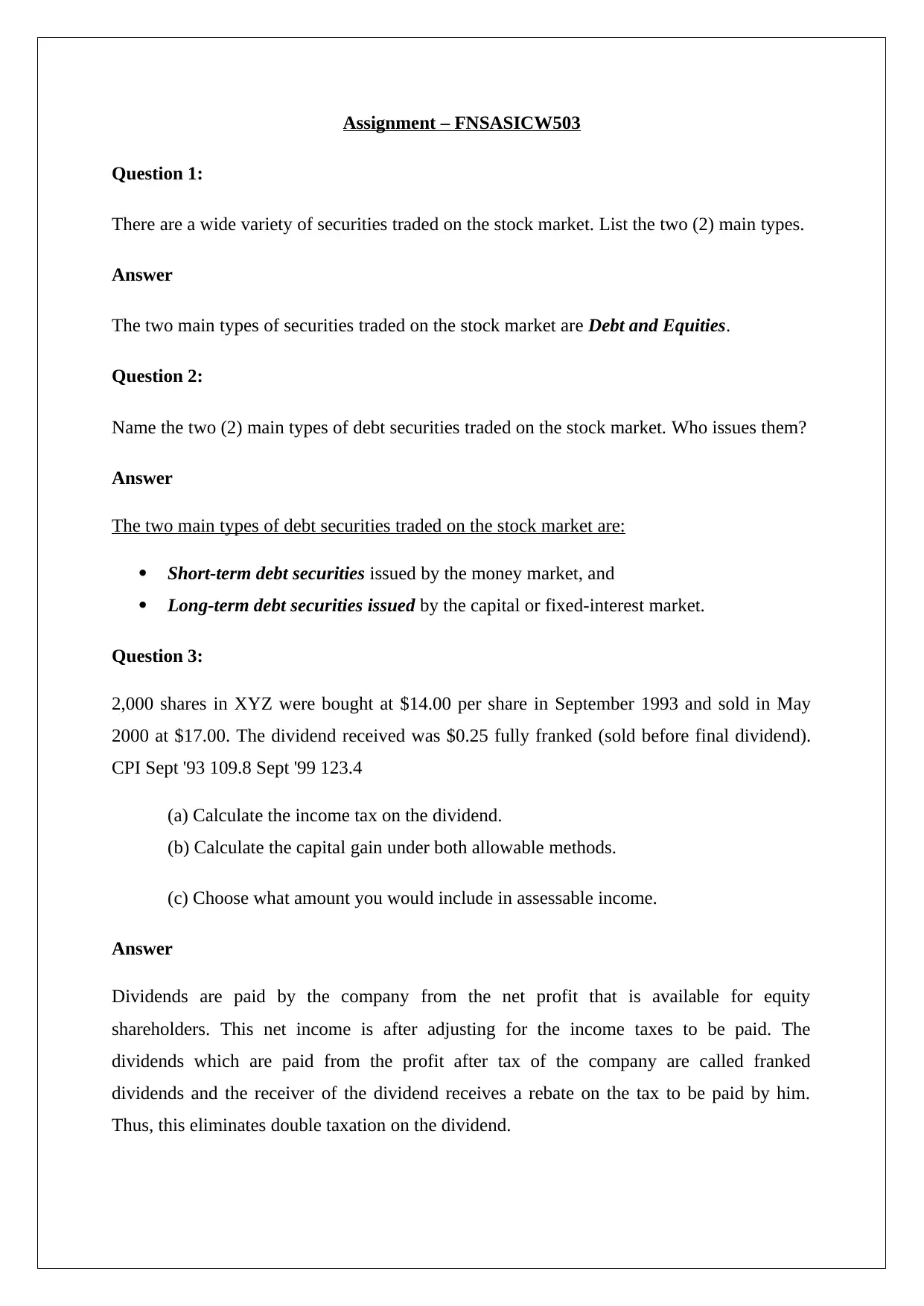
Assignment – FNSASICW503
Question 1:
There are a wide variety of securities traded on the stock market. List the two (2) main types.
Answer
The two main types of securities traded on the stock market are Debt and Equities.
Question 2:
Name the two (2) main types of debt securities traded on the stock market. Who issues them?
Answer
The two main types of debt securities traded on the stock market are:
Short-term debt securities issued by the money market, and
Long-term debt securities issued by the capital or fixed-interest market.
Question 3:
2,000 shares in XYZ were bought at $14.00 per share in September 1993 and sold in May
2000 at $17.00. The dividend received was $0.25 fully franked (sold before final dividend).
CPI Sept '93 109.8 Sept '99 123.4
(a) Calculate the income tax on the dividend.
(b) Calculate the capital gain under both allowable methods.
(c) Choose what amount you would include in assessable income.
Answer
Dividends are paid by the company from the net profit that is available for equity
shareholders. This net income is after adjusting for the income taxes to be paid. The
dividends which are paid from the profit after tax of the company are called franked
dividends and the receiver of the dividend receives a rebate on the tax to be paid by him.
Thus, this eliminates double taxation on the dividend.
Question 1:
There are a wide variety of securities traded on the stock market. List the two (2) main types.
Answer
The two main types of securities traded on the stock market are Debt and Equities.
Question 2:
Name the two (2) main types of debt securities traded on the stock market. Who issues them?
Answer
The two main types of debt securities traded on the stock market are:
Short-term debt securities issued by the money market, and
Long-term debt securities issued by the capital or fixed-interest market.
Question 3:
2,000 shares in XYZ were bought at $14.00 per share in September 1993 and sold in May
2000 at $17.00. The dividend received was $0.25 fully franked (sold before final dividend).
CPI Sept '93 109.8 Sept '99 123.4
(a) Calculate the income tax on the dividend.
(b) Calculate the capital gain under both allowable methods.
(c) Choose what amount you would include in assessable income.
Answer
Dividends are paid by the company from the net profit that is available for equity
shareholders. This net income is after adjusting for the income taxes to be paid. The
dividends which are paid from the profit after tax of the company are called franked
dividends and the receiver of the dividend receives a rebate on the tax to be paid by him.
Thus, this eliminates double taxation on the dividend.
Paraphrase This Document
Need a fresh take? Get an instant paraphrase of this document with our AI Paraphraser
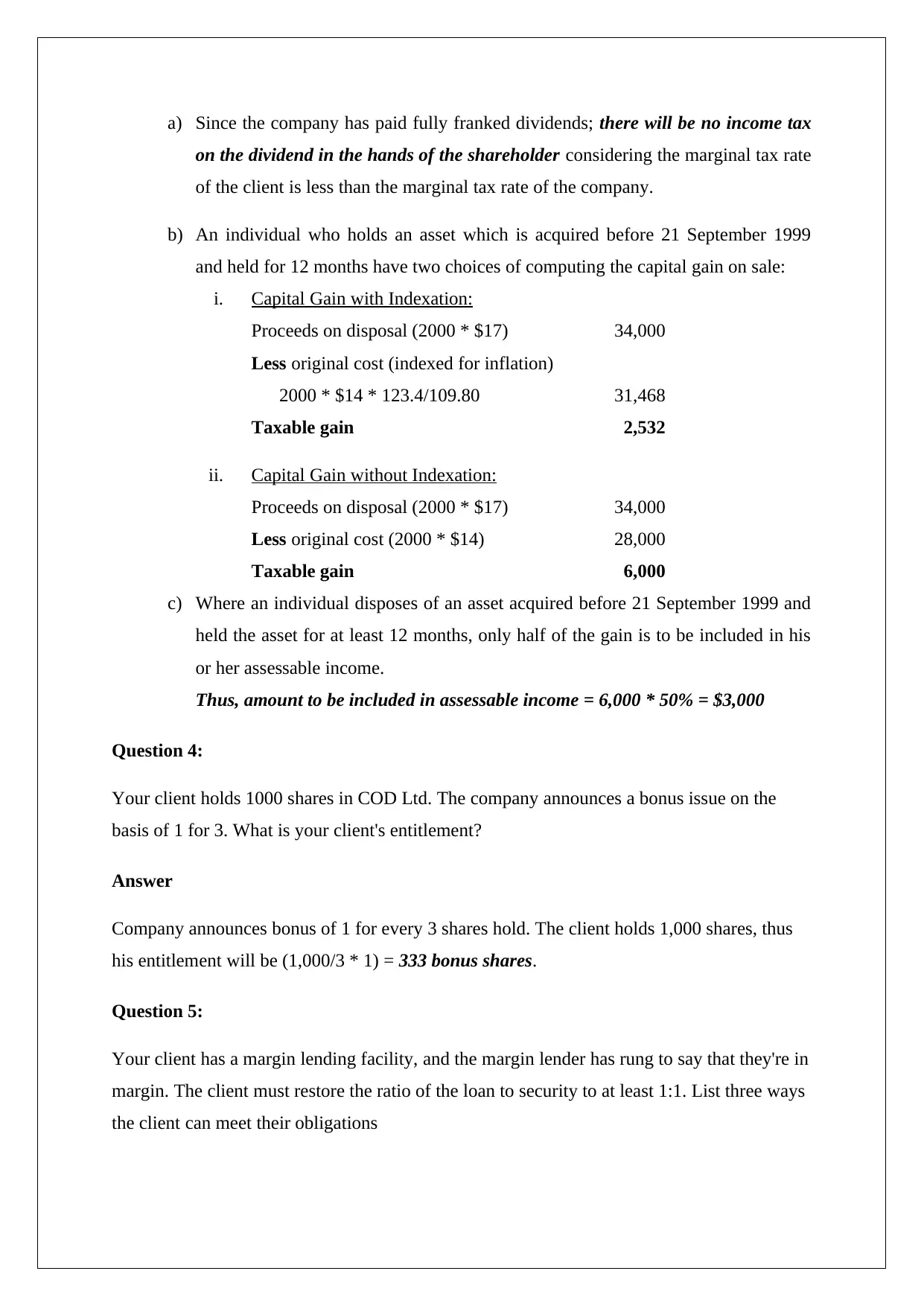
a) Since the company has paid fully franked dividends; there will be no income tax
on the dividend in the hands of the shareholder considering the marginal tax rate
of the client is less than the marginal tax rate of the company.
b) An individual who holds an asset which is acquired before 21 September 1999
and held for 12 months have two choices of computing the capital gain on sale:
i. Capital Gain with Indexation:
Proceeds on disposal (2000 * $17) 34,000
Less original cost (indexed for inflation)
2000 * $14 * 123.4/109.80 31,468
Taxable gain 2,532
ii. Capital Gain without Indexation:
Proceeds on disposal (2000 * $17) 34,000
Less original cost (2000 * $14) 28,000
Taxable gain 6,000
c) Where an individual disposes of an asset acquired before 21 September 1999 and
held the asset for at least 12 months, only half of the gain is to be included in his
or her assessable income.
Thus, amount to be included in assessable income = 6,000 * 50% = $3,000
Question 4:
Your client holds 1000 shares in COD Ltd. The company announces a bonus issue on the
basis of 1 for 3. What is your client's entitlement?
Answer
Company announces bonus of 1 for every 3 shares hold. The client holds 1,000 shares, thus
his entitlement will be (1,000/3 * 1) = 333 bonus shares.
Question 5:
Your client has a margin lending facility, and the margin lender has rung to say that they're in
margin. The client must restore the ratio of the loan to security to at least 1:1. List three ways
the client can meet their obligations
on the dividend in the hands of the shareholder considering the marginal tax rate
of the client is less than the marginal tax rate of the company.
b) An individual who holds an asset which is acquired before 21 September 1999
and held for 12 months have two choices of computing the capital gain on sale:
i. Capital Gain with Indexation:
Proceeds on disposal (2000 * $17) 34,000
Less original cost (indexed for inflation)
2000 * $14 * 123.4/109.80 31,468
Taxable gain 2,532
ii. Capital Gain without Indexation:
Proceeds on disposal (2000 * $17) 34,000
Less original cost (2000 * $14) 28,000
Taxable gain 6,000
c) Where an individual disposes of an asset acquired before 21 September 1999 and
held the asset for at least 12 months, only half of the gain is to be included in his
or her assessable income.
Thus, amount to be included in assessable income = 6,000 * 50% = $3,000
Question 4:
Your client holds 1000 shares in COD Ltd. The company announces a bonus issue on the
basis of 1 for 3. What is your client's entitlement?
Answer
Company announces bonus of 1 for every 3 shares hold. The client holds 1,000 shares, thus
his entitlement will be (1,000/3 * 1) = 333 bonus shares.
Question 5:
Your client has a margin lending facility, and the margin lender has rung to say that they're in
margin. The client must restore the ratio of the loan to security to at least 1:1. List three ways
the client can meet their obligations
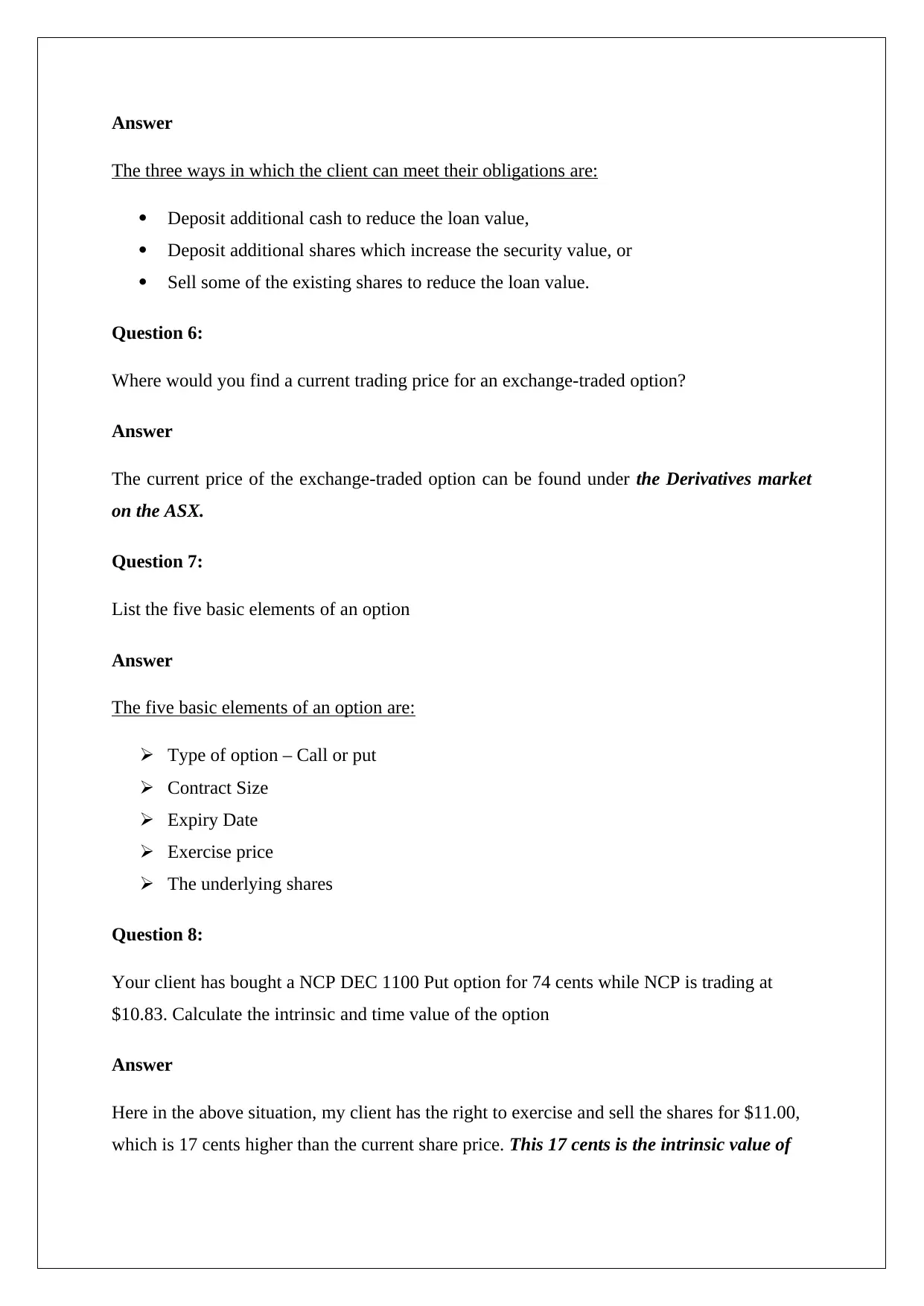
Answer
The three ways in which the client can meet their obligations are:
Deposit additional cash to reduce the loan value,
Deposit additional shares which increase the security value, or
Sell some of the existing shares to reduce the loan value.
Question 6:
Where would you find a current trading price for an exchange-traded option?
Answer
The current price of the exchange-traded option can be found under the Derivatives market
on the ASX.
Question 7:
List the five basic elements of an option
Answer
The five basic elements of an option are:
Type of option – Call or put
Contract Size
Expiry Date
Exercise price
The underlying shares
Question 8:
Your client has bought a NCP DEC 1100 Put option for 74 cents while NCP is trading at
$10.83. Calculate the intrinsic and time value of the option
Answer
Here in the above situation, my client has the right to exercise and sell the shares for $11.00,
which is 17 cents higher than the current share price. This 17 cents is the intrinsic value of
The three ways in which the client can meet their obligations are:
Deposit additional cash to reduce the loan value,
Deposit additional shares which increase the security value, or
Sell some of the existing shares to reduce the loan value.
Question 6:
Where would you find a current trading price for an exchange-traded option?
Answer
The current price of the exchange-traded option can be found under the Derivatives market
on the ASX.
Question 7:
List the five basic elements of an option
Answer
The five basic elements of an option are:
Type of option – Call or put
Contract Size
Expiry Date
Exercise price
The underlying shares
Question 8:
Your client has bought a NCP DEC 1100 Put option for 74 cents while NCP is trading at
$10.83. Calculate the intrinsic and time value of the option
Answer
Here in the above situation, my client has the right to exercise and sell the shares for $11.00,
which is 17 cents higher than the current share price. This 17 cents is the intrinsic value of
⊘ This is a preview!⊘
Do you want full access?
Subscribe today to unlock all pages.

Trusted by 1+ million students worldwide
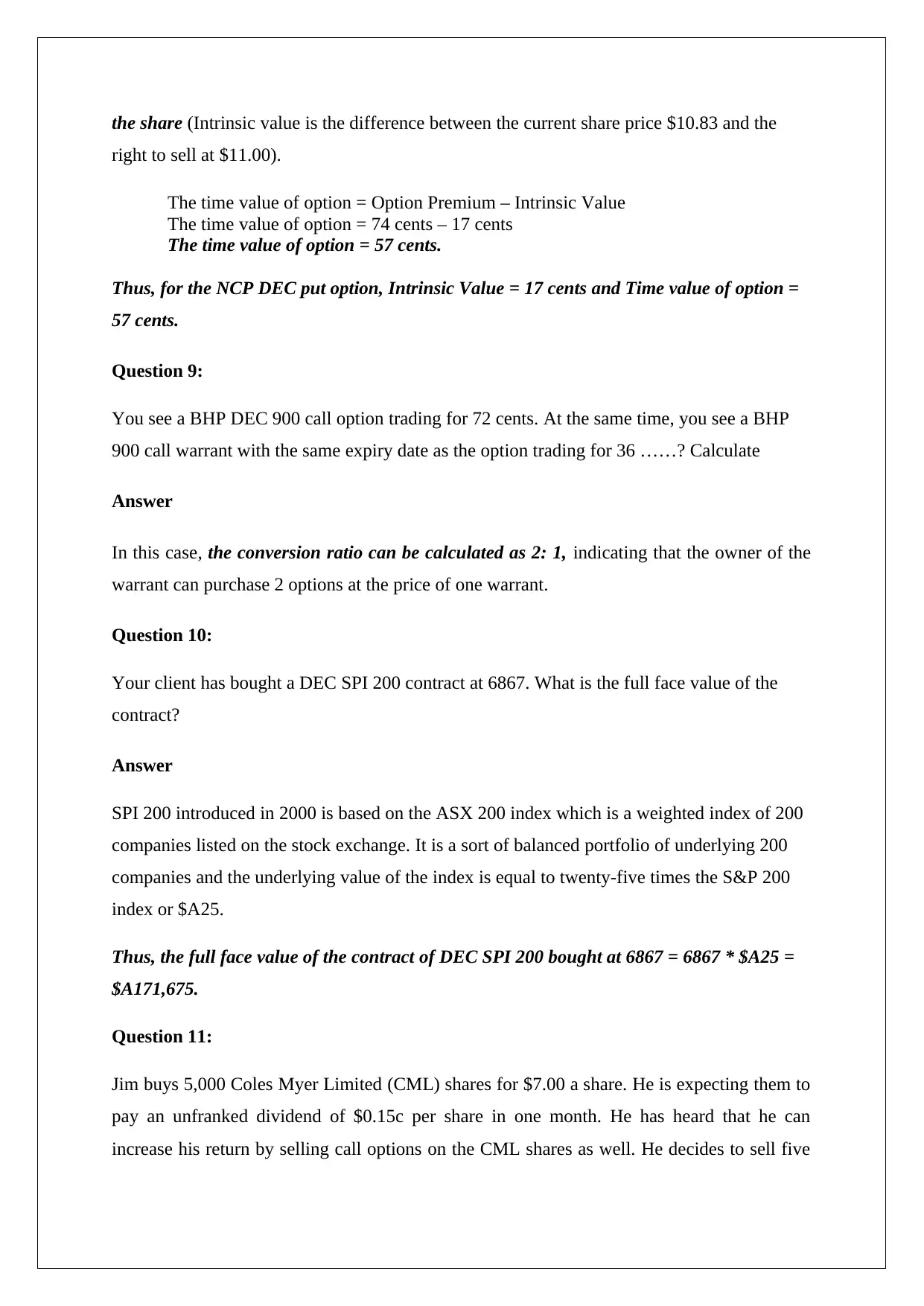
the share (Intrinsic value is the difference between the current share price $10.83 and the
right to sell at $11.00).
The time value of option = Option Premium – Intrinsic Value
The time value of option = 74 cents – 17 cents
The time value of option = 57 cents.
Thus, for the NCP DEC put option, Intrinsic Value = 17 cents and Time value of option =
57 cents.
Question 9:
You see a BHP DEC 900 call option trading for 72 cents. At the same time, you see a BHP
900 call warrant with the same expiry date as the option trading for 36 ……? Calculate
Answer
In this case, the conversion ratio can be calculated as 2: 1, indicating that the owner of the
warrant can purchase 2 options at the price of one warrant.
Question 10:
Your client has bought a DEC SPI 200 contract at 6867. What is the full face value of the
contract?
Answer
SPI 200 introduced in 2000 is based on the ASX 200 index which is a weighted index of 200
companies listed on the stock exchange. It is a sort of balanced portfolio of underlying 200
companies and the underlying value of the index is equal to twenty-five times the S&P 200
index or $A25.
Thus, the full face value of the contract of DEC SPI 200 bought at 6867 = 6867 * $A25 =
$A171,675.
Question 11:
Jim buys 5,000 Coles Myer Limited (CML) shares for $7.00 a share. He is expecting them to
pay an unfranked dividend of $0.15c per share in one month. He has heard that he can
increase his return by selling call options on the CML shares as well. He decides to sell five
right to sell at $11.00).
The time value of option = Option Premium – Intrinsic Value
The time value of option = 74 cents – 17 cents
The time value of option = 57 cents.
Thus, for the NCP DEC put option, Intrinsic Value = 17 cents and Time value of option =
57 cents.
Question 9:
You see a BHP DEC 900 call option trading for 72 cents. At the same time, you see a BHP
900 call warrant with the same expiry date as the option trading for 36 ……? Calculate
Answer
In this case, the conversion ratio can be calculated as 2: 1, indicating that the owner of the
warrant can purchase 2 options at the price of one warrant.
Question 10:
Your client has bought a DEC SPI 200 contract at 6867. What is the full face value of the
contract?
Answer
SPI 200 introduced in 2000 is based on the ASX 200 index which is a weighted index of 200
companies listed on the stock exchange. It is a sort of balanced portfolio of underlying 200
companies and the underlying value of the index is equal to twenty-five times the S&P 200
index or $A25.
Thus, the full face value of the contract of DEC SPI 200 bought at 6867 = 6867 * $A25 =
$A171,675.
Question 11:
Jim buys 5,000 Coles Myer Limited (CML) shares for $7.00 a share. He is expecting them to
pay an unfranked dividend of $0.15c per share in one month. He has heard that he can
increase his return by selling call options on the CML shares as well. He decides to sell five
Paraphrase This Document
Need a fresh take? Get an instant paraphrase of this document with our AI Paraphraser
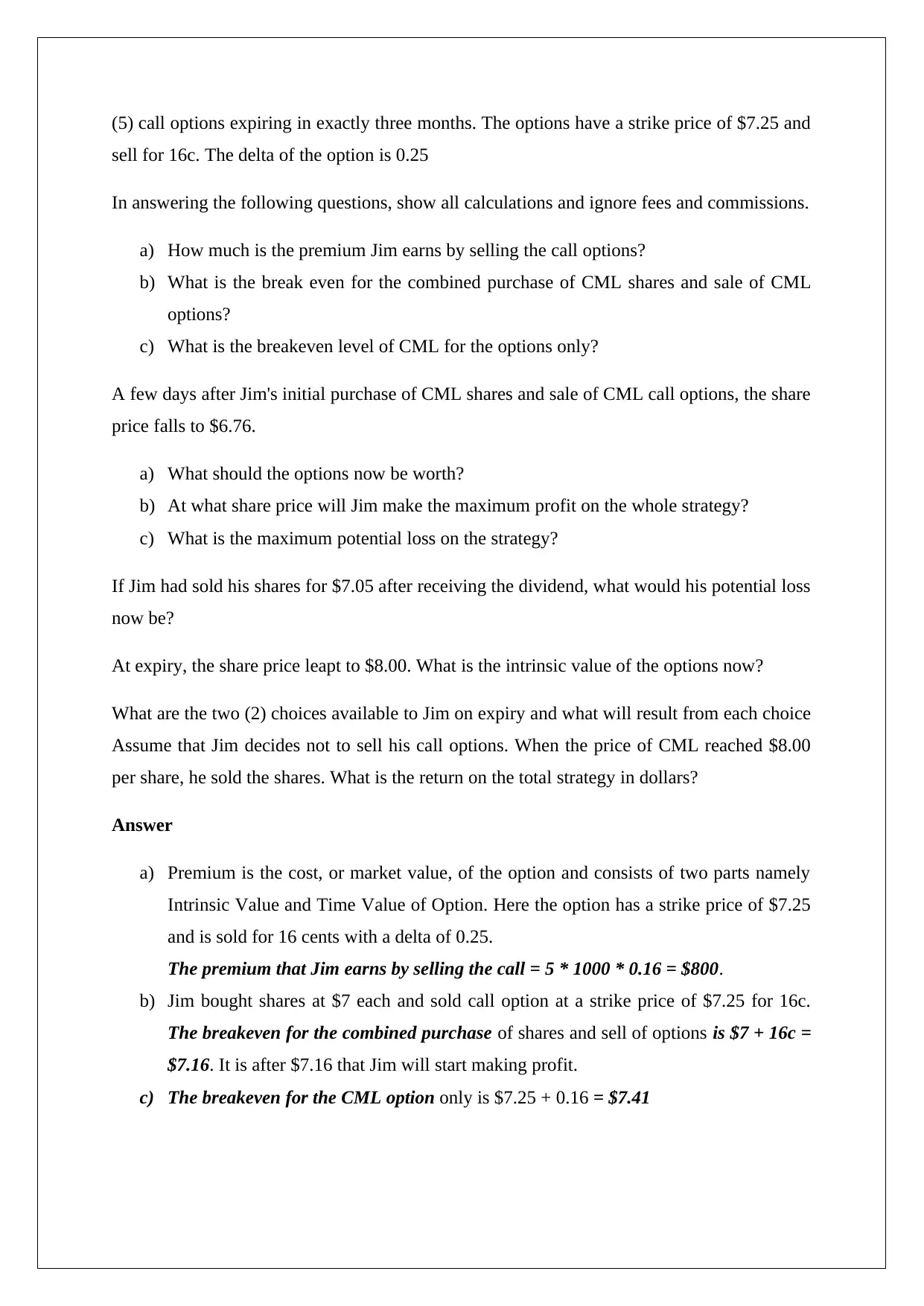
(5) call options expiring in exactly three months. The options have a strike price of $7.25 and
sell for 16c. The delta of the option is 0.25
In answering the following questions, show all calculations and ignore fees and commissions.
a) How much is the premium Jim earns by selling the call options?
b) What is the break even for the combined purchase of CML shares and sale of CML
options?
c) What is the breakeven level of CML for the options only?
A few days after Jim's initial purchase of CML shares and sale of CML call options, the share
price falls to $6.76.
a) What should the options now be worth?
b) At what share price will Jim make the maximum profit on the whole strategy?
c) What is the maximum potential loss on the strategy?
If Jim had sold his shares for $7.05 after receiving the dividend, what would his potential loss
now be?
At expiry, the share price leapt to $8.00. What is the intrinsic value of the options now?
What are the two (2) choices available to Jim on expiry and what will result from each choice
Assume that Jim decides not to sell his call options. When the price of CML reached $8.00
per share, he sold the shares. What is the return on the total strategy in dollars?
Answer
a) Premium is the cost, or market value, of the option and consists of two parts namely
Intrinsic Value and Time Value of Option. Here the option has a strike price of $7.25
and is sold for 16 cents with a delta of 0.25.
The premium that Jim earns by selling the call = 5 * 1000 * 0.16 = $800.
b) Jim bought shares at $7 each and sold call option at a strike price of $7.25 for 16c.
The breakeven for the combined purchase of shares and sell of options is $7 + 16c =
$7.16. It is after $7.16 that Jim will start making profit.
c) The breakeven for the CML option only is $7.25 + 0.16 = $7.41
sell for 16c. The delta of the option is 0.25
In answering the following questions, show all calculations and ignore fees and commissions.
a) How much is the premium Jim earns by selling the call options?
b) What is the break even for the combined purchase of CML shares and sale of CML
options?
c) What is the breakeven level of CML for the options only?
A few days after Jim's initial purchase of CML shares and sale of CML call options, the share
price falls to $6.76.
a) What should the options now be worth?
b) At what share price will Jim make the maximum profit on the whole strategy?
c) What is the maximum potential loss on the strategy?
If Jim had sold his shares for $7.05 after receiving the dividend, what would his potential loss
now be?
At expiry, the share price leapt to $8.00. What is the intrinsic value of the options now?
What are the two (2) choices available to Jim on expiry and what will result from each choice
Assume that Jim decides not to sell his call options. When the price of CML reached $8.00
per share, he sold the shares. What is the return on the total strategy in dollars?
Answer
a) Premium is the cost, or market value, of the option and consists of two parts namely
Intrinsic Value and Time Value of Option. Here the option has a strike price of $7.25
and is sold for 16 cents with a delta of 0.25.
The premium that Jim earns by selling the call = 5 * 1000 * 0.16 = $800.
b) Jim bought shares at $7 each and sold call option at a strike price of $7.25 for 16c.
The breakeven for the combined purchase of shares and sell of options is $7 + 16c =
$7.16. It is after $7.16 that Jim will start making profit.
c) The breakeven for the CML option only is $7.25 + 0.16 = $7.41
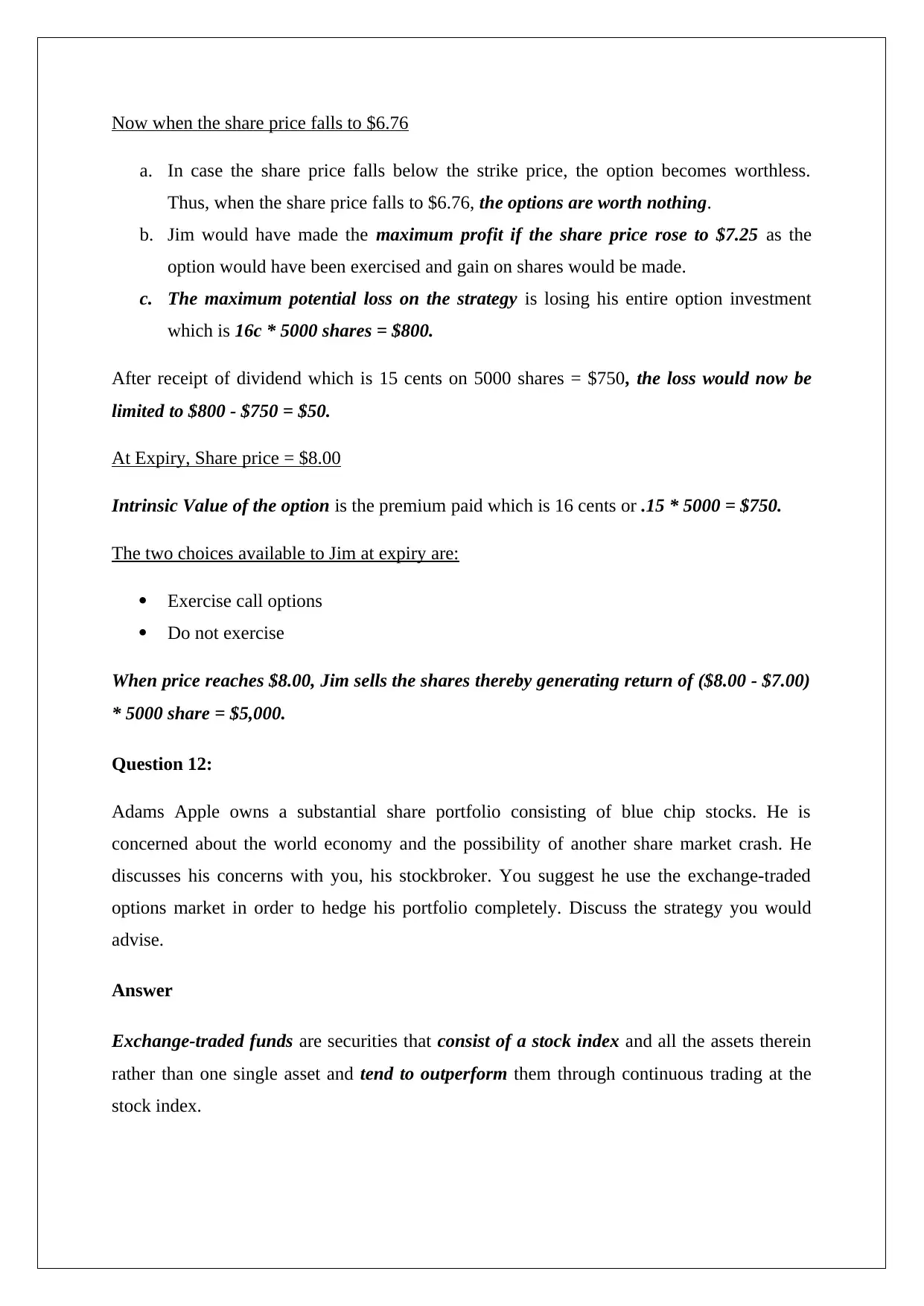
Now when the share price falls to $6.76
a. In case the share price falls below the strike price, the option becomes worthless.
Thus, when the share price falls to $6.76, the options are worth nothing.
b. Jim would have made the maximum profit if the share price rose to $7.25 as the
option would have been exercised and gain on shares would be made.
c. The maximum potential loss on the strategy is losing his entire option investment
which is 16c * 5000 shares = $800.
After receipt of dividend which is 15 cents on 5000 shares = $750, the loss would now be
limited to $800 - $750 = $50.
At Expiry, Share price = $8.00
Intrinsic Value of the option is the premium paid which is 16 cents or .15 * 5000 = $750.
The two choices available to Jim at expiry are:
Exercise call options
Do not exercise
When price reaches $8.00, Jim sells the shares thereby generating return of ($8.00 - $7.00)
* 5000 share = $5,000.
Question 12:
Adams Apple owns a substantial share portfolio consisting of blue chip stocks. He is
concerned about the world economy and the possibility of another share market crash. He
discusses his concerns with you, his stockbroker. You suggest he use the exchange-traded
options market in order to hedge his portfolio completely. Discuss the strategy you would
advise.
Answer
Exchange-traded funds are securities that consist of a stock index and all the assets therein
rather than one single asset and tend to outperform them through continuous trading at the
stock index.
a. In case the share price falls below the strike price, the option becomes worthless.
Thus, when the share price falls to $6.76, the options are worth nothing.
b. Jim would have made the maximum profit if the share price rose to $7.25 as the
option would have been exercised and gain on shares would be made.
c. The maximum potential loss on the strategy is losing his entire option investment
which is 16c * 5000 shares = $800.
After receipt of dividend which is 15 cents on 5000 shares = $750, the loss would now be
limited to $800 - $750 = $50.
At Expiry, Share price = $8.00
Intrinsic Value of the option is the premium paid which is 16 cents or .15 * 5000 = $750.
The two choices available to Jim at expiry are:
Exercise call options
Do not exercise
When price reaches $8.00, Jim sells the shares thereby generating return of ($8.00 - $7.00)
* 5000 share = $5,000.
Question 12:
Adams Apple owns a substantial share portfolio consisting of blue chip stocks. He is
concerned about the world economy and the possibility of another share market crash. He
discusses his concerns with you, his stockbroker. You suggest he use the exchange-traded
options market in order to hedge his portfolio completely. Discuss the strategy you would
advise.
Answer
Exchange-traded funds are securities that consist of a stock index and all the assets therein
rather than one single asset and tend to outperform them through continuous trading at the
stock index.
⊘ This is a preview!⊘
Do you want full access?
Subscribe today to unlock all pages.

Trusted by 1+ million students worldwide
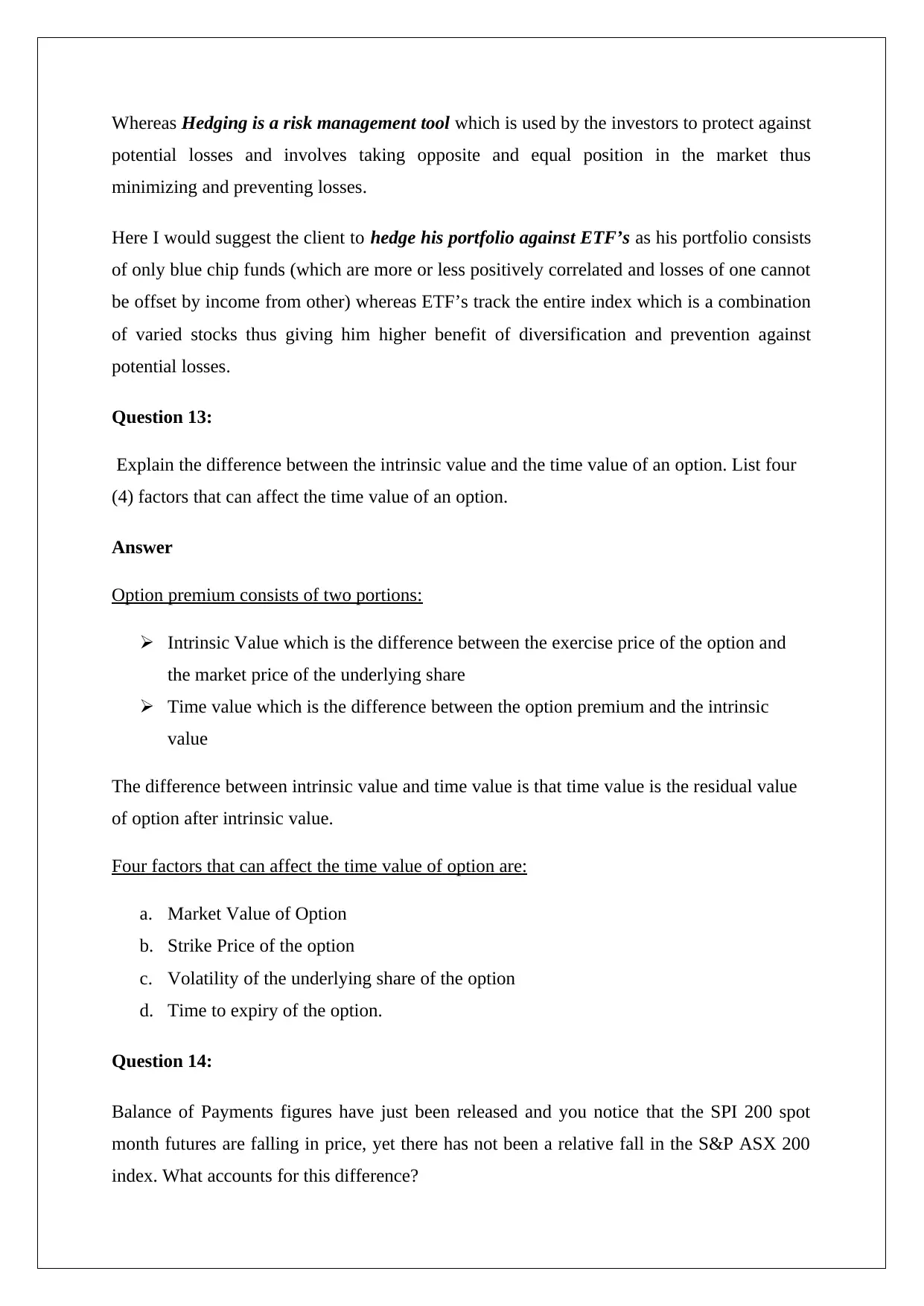
Whereas Hedging is a risk management tool which is used by the investors to protect against
potential losses and involves taking opposite and equal position in the market thus
minimizing and preventing losses.
Here I would suggest the client to hedge his portfolio against ETF’s as his portfolio consists
of only blue chip funds (which are more or less positively correlated and losses of one cannot
be offset by income from other) whereas ETF’s track the entire index which is a combination
of varied stocks thus giving him higher benefit of diversification and prevention against
potential losses.
Question 13:
Explain the difference between the intrinsic value and the time value of an option. List four
(4) factors that can affect the time value of an option.
Answer
Option premium consists of two portions:
Intrinsic Value which is the difference between the exercise price of the option and
the market price of the underlying share
Time value which is the difference between the option premium and the intrinsic
value
The difference between intrinsic value and time value is that time value is the residual value
of option after intrinsic value.
Four factors that can affect the time value of option are:
a. Market Value of Option
b. Strike Price of the option
c. Volatility of the underlying share of the option
d. Time to expiry of the option.
Question 14:
Balance of Payments figures have just been released and you notice that the SPI 200 spot
month futures are falling in price, yet there has not been a relative fall in the S&P ASX 200
index. What accounts for this difference?
potential losses and involves taking opposite and equal position in the market thus
minimizing and preventing losses.
Here I would suggest the client to hedge his portfolio against ETF’s as his portfolio consists
of only blue chip funds (which are more or less positively correlated and losses of one cannot
be offset by income from other) whereas ETF’s track the entire index which is a combination
of varied stocks thus giving him higher benefit of diversification and prevention against
potential losses.
Question 13:
Explain the difference between the intrinsic value and the time value of an option. List four
(4) factors that can affect the time value of an option.
Answer
Option premium consists of two portions:
Intrinsic Value which is the difference between the exercise price of the option and
the market price of the underlying share
Time value which is the difference between the option premium and the intrinsic
value
The difference between intrinsic value and time value is that time value is the residual value
of option after intrinsic value.
Four factors that can affect the time value of option are:
a. Market Value of Option
b. Strike Price of the option
c. Volatility of the underlying share of the option
d. Time to expiry of the option.
Question 14:
Balance of Payments figures have just been released and you notice that the SPI 200 spot
month futures are falling in price, yet there has not been a relative fall in the S&P ASX 200
index. What accounts for this difference?
Paraphrase This Document
Need a fresh take? Get an instant paraphrase of this document with our AI Paraphraser
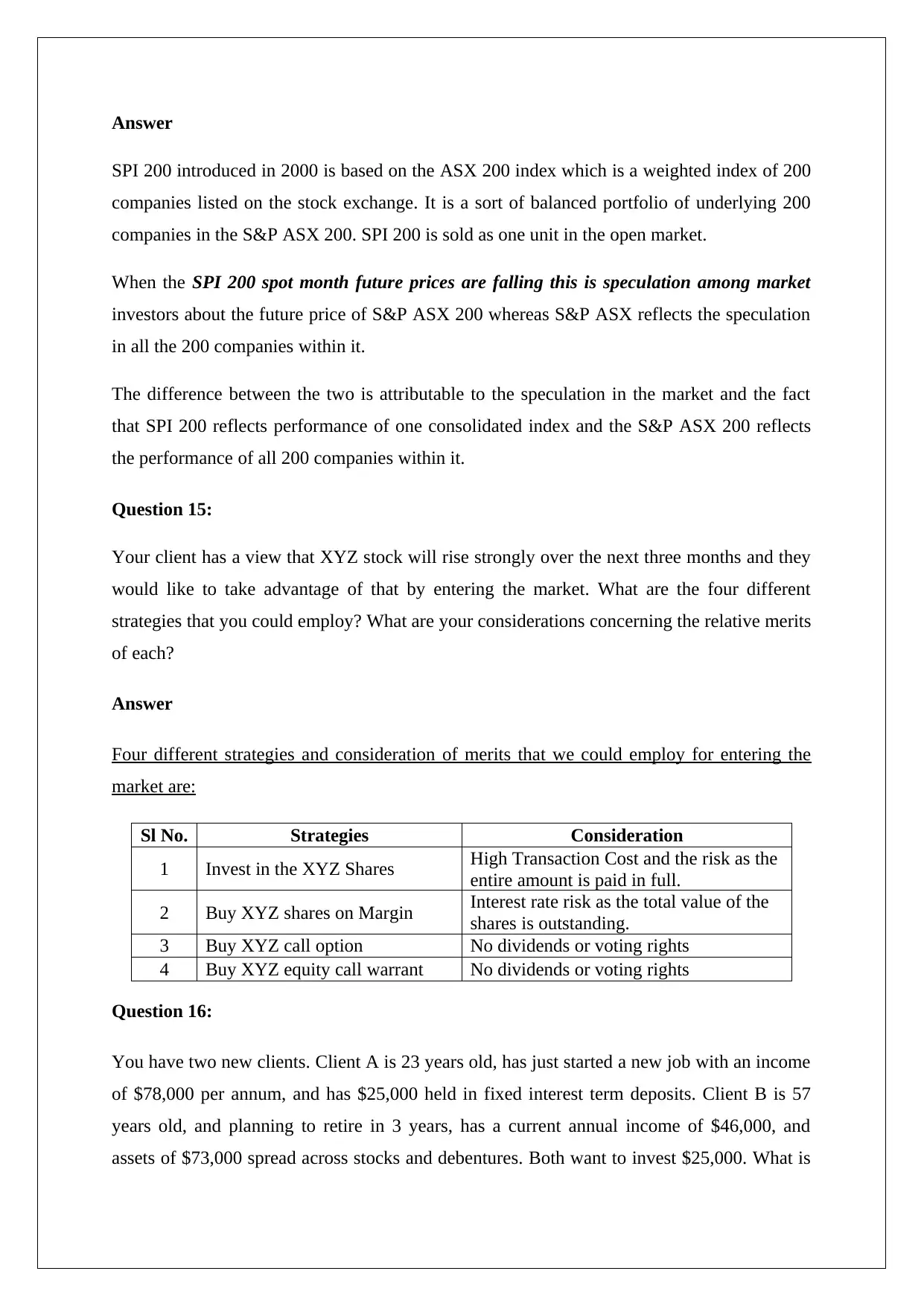
Answer
SPI 200 introduced in 2000 is based on the ASX 200 index which is a weighted index of 200
companies listed on the stock exchange. It is a sort of balanced portfolio of underlying 200
companies in the S&P ASX 200. SPI 200 is sold as one unit in the open market.
When the SPI 200 spot month future prices are falling this is speculation among market
investors about the future price of S&P ASX 200 whereas S&P ASX reflects the speculation
in all the 200 companies within it.
The difference between the two is attributable to the speculation in the market and the fact
that SPI 200 reflects performance of one consolidated index and the S&P ASX 200 reflects
the performance of all 200 companies within it.
Question 15:
Your client has a view that XYZ stock will rise strongly over the next three months and they
would like to take advantage of that by entering the market. What are the four different
strategies that you could employ? What are your considerations concerning the relative merits
of each?
Answer
Four different strategies and consideration of merits that we could employ for entering the
market are:
Sl No. Strategies Consideration
1 Invest in the XYZ Shares High Transaction Cost and the risk as the
entire amount is paid in full.
2 Buy XYZ shares on Margin Interest rate risk as the total value of the
shares is outstanding.
3 Buy XYZ call option No dividends or voting rights
4 Buy XYZ equity call warrant No dividends or voting rights
Question 16:
You have two new clients. Client A is 23 years old, has just started a new job with an income
of $78,000 per annum, and has $25,000 held in fixed interest term deposits. Client B is 57
years old, and planning to retire in 3 years, has a current annual income of $46,000, and
assets of $73,000 spread across stocks and debentures. Both want to invest $25,000. What is
SPI 200 introduced in 2000 is based on the ASX 200 index which is a weighted index of 200
companies listed on the stock exchange. It is a sort of balanced portfolio of underlying 200
companies in the S&P ASX 200. SPI 200 is sold as one unit in the open market.
When the SPI 200 spot month future prices are falling this is speculation among market
investors about the future price of S&P ASX 200 whereas S&P ASX reflects the speculation
in all the 200 companies within it.
The difference between the two is attributable to the speculation in the market and the fact
that SPI 200 reflects performance of one consolidated index and the S&P ASX 200 reflects
the performance of all 200 companies within it.
Question 15:
Your client has a view that XYZ stock will rise strongly over the next three months and they
would like to take advantage of that by entering the market. What are the four different
strategies that you could employ? What are your considerations concerning the relative merits
of each?
Answer
Four different strategies and consideration of merits that we could employ for entering the
market are:
Sl No. Strategies Consideration
1 Invest in the XYZ Shares High Transaction Cost and the risk as the
entire amount is paid in full.
2 Buy XYZ shares on Margin Interest rate risk as the total value of the
shares is outstanding.
3 Buy XYZ call option No dividends or voting rights
4 Buy XYZ equity call warrant No dividends or voting rights
Question 16:
You have two new clients. Client A is 23 years old, has just started a new job with an income
of $78,000 per annum, and has $25,000 held in fixed interest term deposits. Client B is 57
years old, and planning to retire in 3 years, has a current annual income of $46,000, and
assets of $73,000 spread across stocks and debentures. Both want to invest $25,000. What is
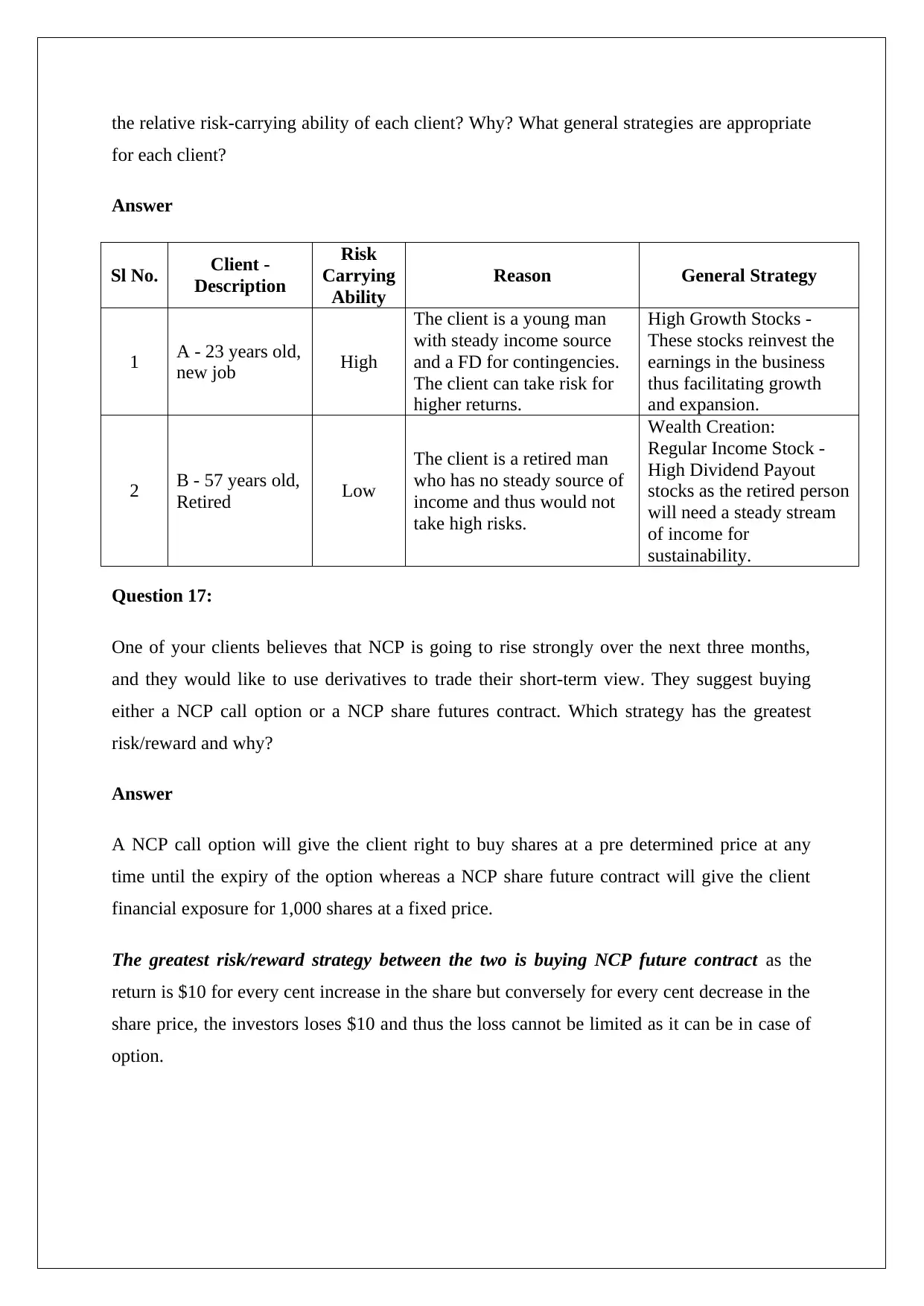
the relative risk-carrying ability of each client? Why? What general strategies are appropriate
for each client?
Answer
Sl No. Client -
Description
Risk
Carrying
Ability
Reason General Strategy
1 A - 23 years old,
new job High
The client is a young man
with steady income source
and a FD for contingencies.
The client can take risk for
higher returns.
High Growth Stocks -
These stocks reinvest the
earnings in the business
thus facilitating growth
and expansion.
2 B - 57 years old,
Retired Low
The client is a retired man
who has no steady source of
income and thus would not
take high risks.
Wealth Creation:
Regular Income Stock -
High Dividend Payout
stocks as the retired person
will need a steady stream
of income for
sustainability.
Question 17:
One of your clients believes that NCP is going to rise strongly over the next three months,
and they would like to use derivatives to trade their short-term view. They suggest buying
either a NCP call option or a NCP share futures contract. Which strategy has the greatest
risk/reward and why?
Answer
A NCP call option will give the client right to buy shares at a pre determined price at any
time until the expiry of the option whereas a NCP share future contract will give the client
financial exposure for 1,000 shares at a fixed price.
The greatest risk/reward strategy between the two is buying NCP future contract as the
return is $10 for every cent increase in the share but conversely for every cent decrease in the
share price, the investors loses $10 and thus the loss cannot be limited as it can be in case of
option.
for each client?
Answer
Sl No. Client -
Description
Risk
Carrying
Ability
Reason General Strategy
1 A - 23 years old,
new job High
The client is a young man
with steady income source
and a FD for contingencies.
The client can take risk for
higher returns.
High Growth Stocks -
These stocks reinvest the
earnings in the business
thus facilitating growth
and expansion.
2 B - 57 years old,
Retired Low
The client is a retired man
who has no steady source of
income and thus would not
take high risks.
Wealth Creation:
Regular Income Stock -
High Dividend Payout
stocks as the retired person
will need a steady stream
of income for
sustainability.
Question 17:
One of your clients believes that NCP is going to rise strongly over the next three months,
and they would like to use derivatives to trade their short-term view. They suggest buying
either a NCP call option or a NCP share futures contract. Which strategy has the greatest
risk/reward and why?
Answer
A NCP call option will give the client right to buy shares at a pre determined price at any
time until the expiry of the option whereas a NCP share future contract will give the client
financial exposure for 1,000 shares at a fixed price.
The greatest risk/reward strategy between the two is buying NCP future contract as the
return is $10 for every cent increase in the share but conversely for every cent decrease in the
share price, the investors loses $10 and thus the loss cannot be limited as it can be in case of
option.
⊘ This is a preview!⊘
Do you want full access?
Subscribe today to unlock all pages.

Trusted by 1+ million students worldwide
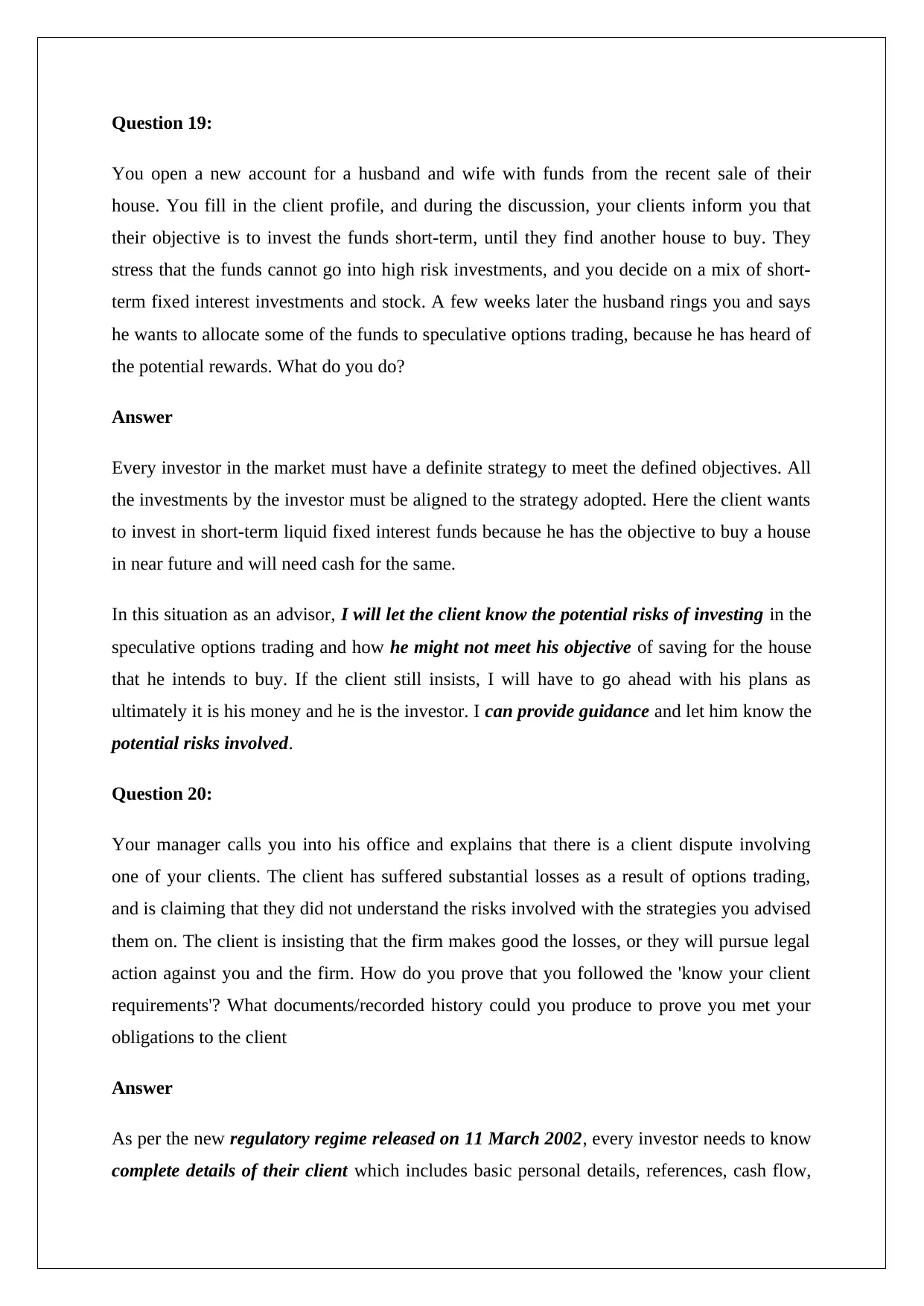
Question 19:
You open a new account for a husband and wife with funds from the recent sale of their
house. You fill in the client profile, and during the discussion, your clients inform you that
their objective is to invest the funds short-term, until they find another house to buy. They
stress that the funds cannot go into high risk investments, and you decide on a mix of short-
term fixed interest investments and stock. A few weeks later the husband rings you and says
he wants to allocate some of the funds to speculative options trading, because he has heard of
the potential rewards. What do you do?
Answer
Every investor in the market must have a definite strategy to meet the defined objectives. All
the investments by the investor must be aligned to the strategy adopted. Here the client wants
to invest in short-term liquid fixed interest funds because he has the objective to buy a house
in near future and will need cash for the same.
In this situation as an advisor, I will let the client know the potential risks of investing in the
speculative options trading and how he might not meet his objective of saving for the house
that he intends to buy. If the client still insists, I will have to go ahead with his plans as
ultimately it is his money and he is the investor. I can provide guidance and let him know the
potential risks involved.
Question 20:
Your manager calls you into his office and explains that there is a client dispute involving
one of your clients. The client has suffered substantial losses as a result of options trading,
and is claiming that they did not understand the risks involved with the strategies you advised
them on. The client is insisting that the firm makes good the losses, or they will pursue legal
action against you and the firm. How do you prove that you followed the 'know your client
requirements'? What documents/recorded history could you produce to prove you met your
obligations to the client
Answer
As per the new regulatory regime released on 11 March 2002, every investor needs to know
complete details of their client which includes basic personal details, references, cash flow,
You open a new account for a husband and wife with funds from the recent sale of their
house. You fill in the client profile, and during the discussion, your clients inform you that
their objective is to invest the funds short-term, until they find another house to buy. They
stress that the funds cannot go into high risk investments, and you decide on a mix of short-
term fixed interest investments and stock. A few weeks later the husband rings you and says
he wants to allocate some of the funds to speculative options trading, because he has heard of
the potential rewards. What do you do?
Answer
Every investor in the market must have a definite strategy to meet the defined objectives. All
the investments by the investor must be aligned to the strategy adopted. Here the client wants
to invest in short-term liquid fixed interest funds because he has the objective to buy a house
in near future and will need cash for the same.
In this situation as an advisor, I will let the client know the potential risks of investing in the
speculative options trading and how he might not meet his objective of saving for the house
that he intends to buy. If the client still insists, I will have to go ahead with his plans as
ultimately it is his money and he is the investor. I can provide guidance and let him know the
potential risks involved.
Question 20:
Your manager calls you into his office and explains that there is a client dispute involving
one of your clients. The client has suffered substantial losses as a result of options trading,
and is claiming that they did not understand the risks involved with the strategies you advised
them on. The client is insisting that the firm makes good the losses, or they will pursue legal
action against you and the firm. How do you prove that you followed the 'know your client
requirements'? What documents/recorded history could you produce to prove you met your
obligations to the client
Answer
As per the new regulatory regime released on 11 March 2002, every investor needs to know
complete details of their client which includes basic personal details, references, cash flow,
Paraphrase This Document
Need a fresh take? Get an instant paraphrase of this document with our AI Paraphraser
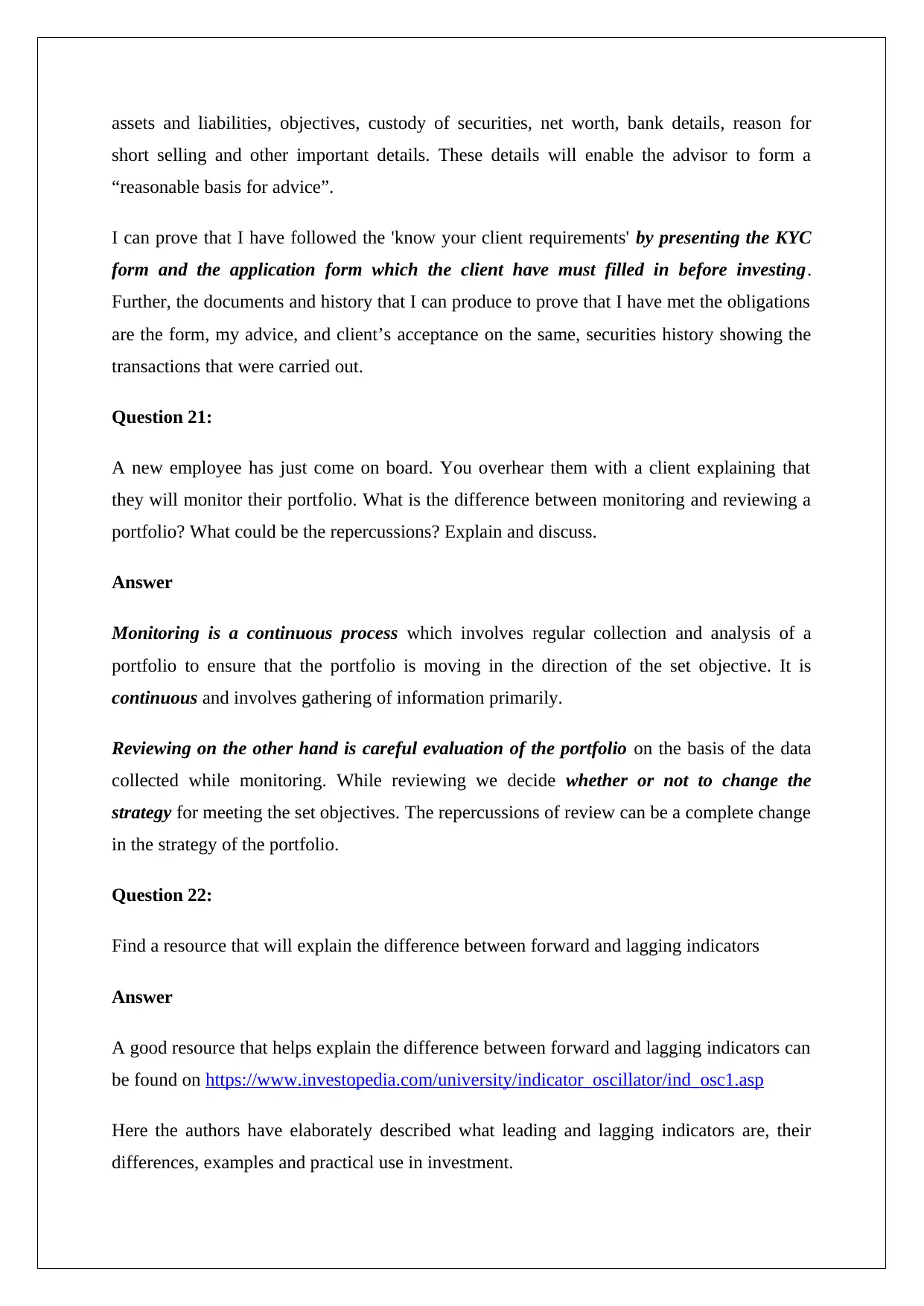
assets and liabilities, objectives, custody of securities, net worth, bank details, reason for
short selling and other important details. These details will enable the advisor to form a
“reasonable basis for advice”.
I can prove that I have followed the 'know your client requirements' by presenting the KYC
form and the application form which the client have must filled in before investing.
Further, the documents and history that I can produce to prove that I have met the obligations
are the form, my advice, and client’s acceptance on the same, securities history showing the
transactions that were carried out.
Question 21:
A new employee has just come on board. You overhear them with a client explaining that
they will monitor their portfolio. What is the difference between monitoring and reviewing a
portfolio? What could be the repercussions? Explain and discuss.
Answer
Monitoring is a continuous process which involves regular collection and analysis of a
portfolio to ensure that the portfolio is moving in the direction of the set objective. It is
continuous and involves gathering of information primarily.
Reviewing on the other hand is careful evaluation of the portfolio on the basis of the data
collected while monitoring. While reviewing we decide whether or not to change the
strategy for meeting the set objectives. The repercussions of review can be a complete change
in the strategy of the portfolio.
Question 22:
Find a resource that will explain the difference between forward and lagging indicators
Answer
A good resource that helps explain the difference between forward and lagging indicators can
be found on https://www.investopedia.com/university/indicator_oscillator/ind_osc1.asp
Here the authors have elaborately described what leading and lagging indicators are, their
differences, examples and practical use in investment.
short selling and other important details. These details will enable the advisor to form a
“reasonable basis for advice”.
I can prove that I have followed the 'know your client requirements' by presenting the KYC
form and the application form which the client have must filled in before investing.
Further, the documents and history that I can produce to prove that I have met the obligations
are the form, my advice, and client’s acceptance on the same, securities history showing the
transactions that were carried out.
Question 21:
A new employee has just come on board. You overhear them with a client explaining that
they will monitor their portfolio. What is the difference between monitoring and reviewing a
portfolio? What could be the repercussions? Explain and discuss.
Answer
Monitoring is a continuous process which involves regular collection and analysis of a
portfolio to ensure that the portfolio is moving in the direction of the set objective. It is
continuous and involves gathering of information primarily.
Reviewing on the other hand is careful evaluation of the portfolio on the basis of the data
collected while monitoring. While reviewing we decide whether or not to change the
strategy for meeting the set objectives. The repercussions of review can be a complete change
in the strategy of the portfolio.
Question 22:
Find a resource that will explain the difference between forward and lagging indicators
Answer
A good resource that helps explain the difference between forward and lagging indicators can
be found on https://www.investopedia.com/university/indicator_oscillator/ind_osc1.asp
Here the authors have elaborately described what leading and lagging indicators are, their
differences, examples and practical use in investment.
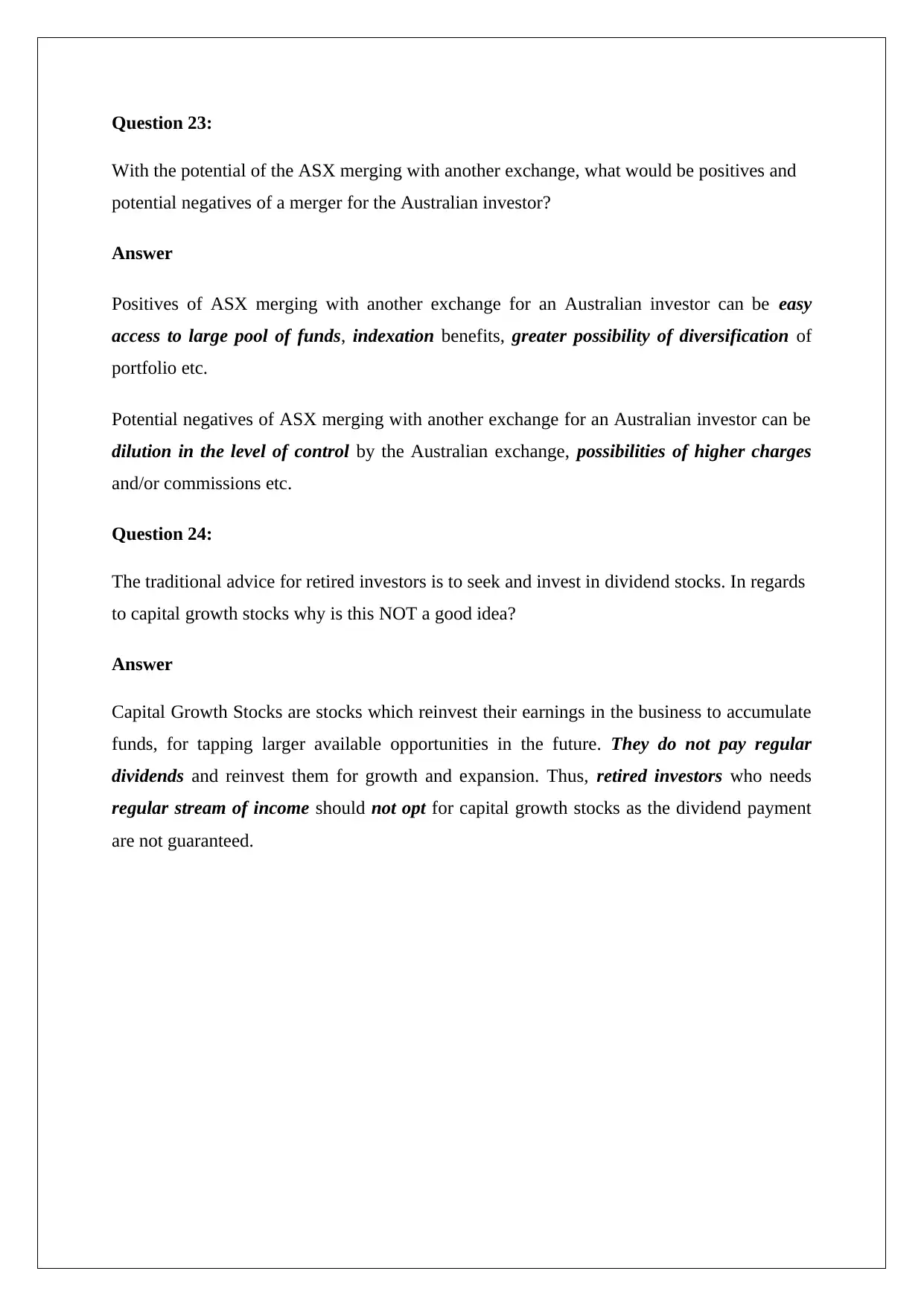
Question 23:
With the potential of the ASX merging with another exchange, what would be positives and
potential negatives of a merger for the Australian investor?
Answer
Positives of ASX merging with another exchange for an Australian investor can be easy
access to large pool of funds, indexation benefits, greater possibility of diversification of
portfolio etc.
Potential negatives of ASX merging with another exchange for an Australian investor can be
dilution in the level of control by the Australian exchange, possibilities of higher charges
and/or commissions etc.
Question 24:
The traditional advice for retired investors is to seek and invest in dividend stocks. In regards
to capital growth stocks why is this NOT a good idea?
Answer
Capital Growth Stocks are stocks which reinvest their earnings in the business to accumulate
funds, for tapping larger available opportunities in the future. They do not pay regular
dividends and reinvest them for growth and expansion. Thus, retired investors who needs
regular stream of income should not opt for capital growth stocks as the dividend payment
are not guaranteed.
With the potential of the ASX merging with another exchange, what would be positives and
potential negatives of a merger for the Australian investor?
Answer
Positives of ASX merging with another exchange for an Australian investor can be easy
access to large pool of funds, indexation benefits, greater possibility of diversification of
portfolio etc.
Potential negatives of ASX merging with another exchange for an Australian investor can be
dilution in the level of control by the Australian exchange, possibilities of higher charges
and/or commissions etc.
Question 24:
The traditional advice for retired investors is to seek and invest in dividend stocks. In regards
to capital growth stocks why is this NOT a good idea?
Answer
Capital Growth Stocks are stocks which reinvest their earnings in the business to accumulate
funds, for tapping larger available opportunities in the future. They do not pay regular
dividends and reinvest them for growth and expansion. Thus, retired investors who needs
regular stream of income should not opt for capital growth stocks as the dividend payment
are not guaranteed.
⊘ This is a preview!⊘
Do you want full access?
Subscribe today to unlock all pages.

Trusted by 1+ million students worldwide
1 out of 19
Related Documents
Your All-in-One AI-Powered Toolkit for Academic Success.
+13062052269
info@desklib.com
Available 24*7 on WhatsApp / Email
![[object Object]](/_next/static/media/star-bottom.7253800d.svg)
Unlock your academic potential
Copyright © 2020–2025 A2Z Services. All Rights Reserved. Developed and managed by ZUCOL.





